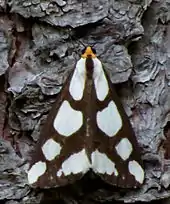Haploa lecontei
Haploa lecontei, or Leconte's haploa, is a moth of the family Erebidae. The species was first described by Félix Édouard Guérin-Méneville in 1832. It is found in North America from Nova Scotia to Georgia, west to Manitoba through Arkansas.
| Leconte's haploa | |
|---|---|
.jpg.webp) | |
| Scientific classification | |
| Domain: | Eukaryota |
| Kingdom: | Animalia |
| Phylum: | Arthropoda |
| Class: | Insecta |
| Order: | Lepidoptera |
| Superfamily: | Noctuoidea |
| Family: | Erebidae |
| Subfamily: | Arctiinae |
| Genus: | Haploa |
| Species: | H. lecontei |
| Binomial name | |
| Haploa lecontei (Guérin-Méneville, 1832) | |
| Synonyms | |
| |
The wingspan is 36–50 mm.
The larvae feed on various plants, including apple, blackberry, peach, spearmint and trembling aspen.

From Ladysmyth, Quebec, Canada
References
- Schmidt, B. C. & Robinson, E. "Species Details Haploa lecontei". University of Alberta Museums. E.H. Strickland Entomological Museum. Retrieved November 9, 2020.
- "930345.00 – 8111 – Haploa lecontei – Leconte's Haploa Moth – (Guérin-Méneville, 1832)". North American Moth Photographers Group. Mississippi State University. Retrieved August 24, 2019.
- Boone, Mike (February 4, 2019). "Species Haploa lecontei - Leconte's Haploa - Hodges#8111". BugGuide. Retrieved August 24, 2019.
- Lotts, Kelly & Naberhaus, Thomas (2017). "Leconte's Haploa Haploa lecontei (Guérin-Méneville, 1832)". Butterflies and Moths of North America. Retrieved August 24, 2019.
This article is issued from Wikipedia. The text is licensed under Creative Commons - Attribution - Sharealike. Additional terms may apply for the media files.